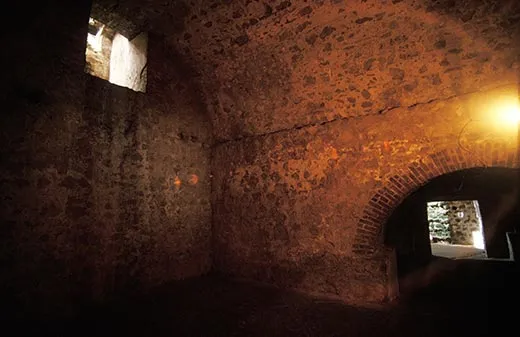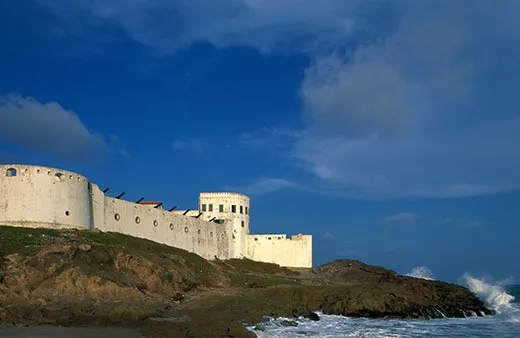Ghana’s Monument to Sorrow and Survival
At Cape Coast Castle, visitors walk in the footsteps of African slaves
/https://tf-cmsv2-smithsonianmag-media.s3.amazonaws.com/filer/Ghana-Cape-Coast-Castle-631.jpg)
When traffic cooperates, it’s a three-hour bus ride from Accra to Cape Coast, Ghana. But an attentive passenger can pass the time watching for roadside signs that display improbable mixes of piety and commercialism (on the outskirts of Accra, the “But Seek First the Kingdom of God Construction Works”) or uproarious irreverence (in Cape Coast, the “Don’t Mind Your Wife Chop Shop”—“chop shop” being Ghanaian slang for a food stand).
Ghana’s attractions include clubs that play the irresistibly danceable local music known as highlife, contact with nature and wildlife in the country’s national parks, and shopping for handicrafts in local markets. But perhaps the most sought-after site in Cape Coast is a centuries-old structure perched above the beach along the Gulf of Guinea. Cape Coast Castle, which is open for guided tours, is one of several Ghanaian colonial-era compounds in which captured Africans were held in dungeons during the slave trade era.
Local cab driver and tour guide Clement Sackey recommends visiting the Castle’s small museum before taking the tour. No amount of reading about or studying the history of slavery can match the visceral reaction a visitor feels on seeing neck, wrist and ankle shackles, or the branding iron used to sear a mark into the skin of a newly captured African.
The collection includes items from the United States. A banner promotes a slave auction held by Alonzo White, a 19th-century slave trader from Charleston, South Carolina. A reproduction of a Mathew Brady photo shows the back of “a slave called Peter with scars from flogging.” The photo gallery also pays tribute to such heroes of the Diaspora as Sojourner Truth, W.E.B. Du Bois (who moved to Ghana at the end of his life and is buried in Accra), Martin Luther King Jr., Malcolm X, Angela Davis, Duke Ellington, Stevie Wonder and Bob Marley.
Just outside the Male Slave Dungeon, wooden doors open to reveal an arched brick ceiling above a stone walkway that slopes down and to the right to the holding cell. Air and light enter the holding cell itself through just three porthole-sized openings near the dungeon ceiling. This cell served as bedroom, dining room and bathroom for hundreds of men at any given time. Guides tell visitors that the walls bear the remnants of the fingernails, skin and blood of those who tried to claw their way out.
A passageway from the cell leads to another underground room that has been converted into a shrine to all those who were held in the dungeon. Memorial wreaths, including one donated by President Barack Obama and his family during a visit in July 2009, line one wall. On another wall, a multi-level platform holds items—animal skins, offering bowls, money—placed in tribute to the prisoners. Dungeons that held African women, some of whom were taken by British colonial officers and held as sex slaves, are also open to visitors.
Captivity in the dungeons ended when the shackled Africans stumbled above ground, blinded by their first exposure to sunlight in months and unaware that they were taking their final steps on African soil. Their contact with the fresh sea air would be brief. They were herded through the courtyard to the exit that became known as the Door of No Return. Beyond lay the slave trader’s ship onto which they’d be crowded for more months of captivity. If they survived the Middle Passage, they would be sold in the New World.
Today, visitors who pass through the Door of No Return emerge onto a beach teeming with activity. Watercraft, vendors and children work and play in the shadow of the cannons that still jut over the Castle’s walls.
In 2007 and 2008, professors Scot French and Maurice Cox of the University of Virginia’s School of Architecture co-taught a course in Cape Coast called “Community as Classroom: Urban Studies and Service Learning in Cape Coast, Ghana.” French believes it’s essential to understand the whole of the country’s history, up to and beyond the end of colonial rule and establishment of Ghana’s independence in 1957. “We didn’t want to just tour Ghana. We wanted to be connected to the community,” he says. “People come to Ghana to see the Castle, but once they’re there, open their eyes to this rich cultural landscape that goes beyond.”
That can mean touring Cape Coast’s Kakum National Park, where you can connect with your inner daredevil during walks across seven treetop-level suspension bridges. (Visitors who lose their nerve on the approach to the first bridge are reassured by guides who pepper their advice with gentle local humor: “If you’re afraid of heights, don’t look down—and remember, God loves you.”) The beaches at Kokrobite, a half-hour west of Accra, draw visitors to local schools’ drumming classes. Stadiums throughout the country offer a chance to take in a soccer match in the only African country to reach the 2010 World Cup quarterfinals. It’s all part of the rhythm of Ghana’s history and contemporary life.


